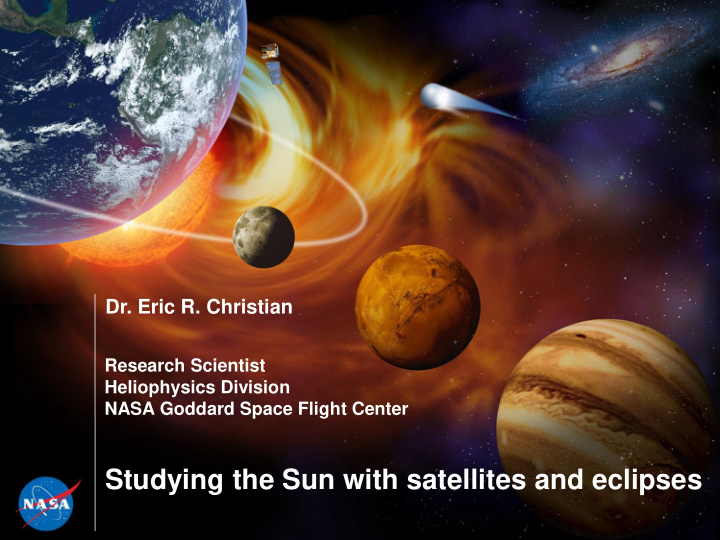



Dr. Eric R. Christian Research Scientist Heliophysics Division NASA Goddard Space Flight Center Studying the Sun with satellites and eclipses
THE SUN The Sun is a variable star. That variability is driven by its magnetic field. The Sun in visible light
The Sun emits infrared, visible, UV, X- ray, and gamma ray photons (light), solar wind, solar energetic particles, and magnetic field. The output is variable for ALL of these components The Sun in X-rays
The Heliosphere (the atmosphere of the Sun) The solar wind has blown a bubble in space that extends way beyond the orbit of Pluto. We call this bubble the “Heliosphere”
SOHO (Solar and Heliospheric Observer) Launched in 1995 Orbiting L1 Lagrange Point Composite image from three SOHO telescopes: EIT (Extreme ultraviolet Imaging Telescope, green) C2 Coronagraph (red) C3 Coronagraph (blue) 10/26/2003
STEREO (Solar Terrestrial Relations Observatory) Launched in 2006 Two spacecraft that moved away from the Earth. Both are now on the far side of the Sun Composite image from four STEREO telescopes: EUVI (Extreme UltraViolet Imager, orange) COR1 (green) COR2 (red) HI 1 (blue) 08/31/2012
SDO (Solar Dynamics Observatory) Launched in 2010 In a tilted (non-equatorial) geosynchronous orbit Image from AIA (Atmospheric Imaging Assembly)
Solar Probe Plus
Solar Probe Plus Solar Probe Plus is a large (685 kg, 4 meters tall) spacecraft that will launch in 2018 and travel to within 4 million miles of the Sun’s surface. The Earth is 25 times further away and even Mercury is 10 times further.
How close will Solar Probe Plus get?
Really close! Solar Probe Plus Closest Approach
NASA 2016 Eclipse Science Greatest Duration of Eclipse 1999 Turkey Maba, Indonesia Woleai, Micronesia
Recommend
More recommend